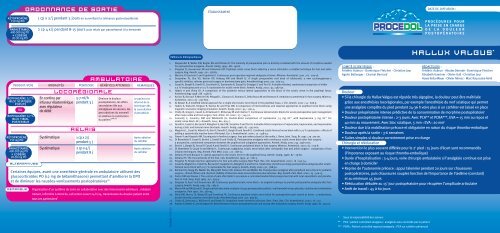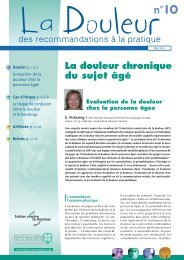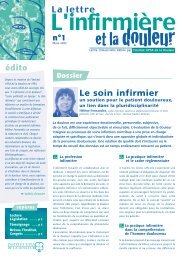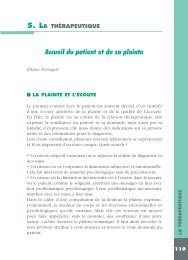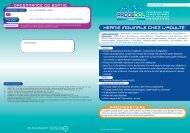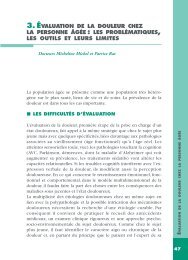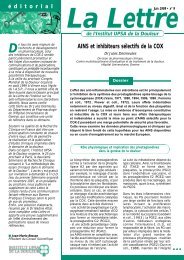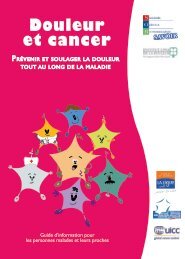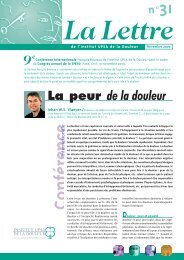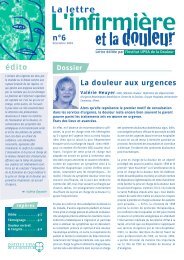Procedol : Hallux valgus - Institut upsa de la douleur
Procedol : Hallux valgus - Institut upsa de la douleur
Procedol : Hallux valgus - Institut upsa de la douleur
Create successful ePaper yourself
Turn your PDF publications into a flip-book with our unique Google optimized e-Paper software.
ORDONNANCE DE SORTIE<br />
ÉTABLISSEMENT<br />
DATE DE DIFFUSION :<br />
kétoprofène<br />
150 mg po<br />
paracétamol<br />
400-500 mg PO<br />
+ codéine<br />
20-30 mg PO<br />
1 cp x 2/j pendant 5 jours en surveil<strong>la</strong>nt <strong>la</strong> tolérance gastroduodénale<br />
2 cp 4 x/j pendant 8-15 jours puis re<strong>la</strong>is par paracétamol à <strong>la</strong> <strong>de</strong>man<strong>de</strong><br />
PROCEDOL<br />
PROCÉDURES POUR<br />
LA PRISE EN CHARGE<br />
DE LA DOULEUR<br />
POSTOPÉRATOIRE<br />
PRODUIT/VOIE<br />
ropivacaïne 0,2 %<br />
bloc sciatique<br />
poplité<br />
ou<br />
ropivacaïne 0,2 %<br />
bloc tibial<br />
posterieur<br />
kétoprofène<br />
150 mg po<br />
paracétamol<br />
400-500 mg PO<br />
+ codéine<br />
20-30 mg PO<br />
ALTERNATIVES<br />
En continu par<br />
infuseur é<strong>la</strong>stomérique<br />
avec régu<strong>la</strong>teur<br />
<strong>de</strong> débit<br />
Systématique<br />
Systématique<br />
LOCORÉGIONALE<br />
5-7 ml/h<br />
pendant 3 j<br />
RELAIS<br />
1 cp x 2/j<br />
pendant 5 j<br />
2 cp x 4/j<br />
pendant 8 j<br />
AMBULATOIRE<br />
Diminue <strong>la</strong> <strong>douleur</strong><br />
postopératoire, les effets<br />
secondaires liés aux<br />
antalgiques <strong>de</strong> secours, les<br />
perturbations du sommeil<br />
et améliore <strong>la</strong> satisfaction<br />
du patient 3,26,27<br />
Certaines équipes, avant une anesthésie générale en ambu<strong>la</strong>toire utilisent <strong>de</strong>s<br />
glucocorticoï<strong>de</strong>s PO (12 mg <strong>de</strong> bétaméthasone) permettant d’améliorer <strong>la</strong> DPO<br />
et <strong>de</strong> diminuer les nausées-vomissements postopératoires 28<br />
REMARQUE<br />
MODALITÉS POSOLOGIE BÉNÉFICES ATTENDUS REMARQUES<br />
Le patient est<br />
informé <strong>de</strong> <strong>la</strong><br />
technique dès<br />
<strong>la</strong> consultation<br />
d’anesthésie<br />
Après ab<strong>la</strong>tion<br />
du cathéter<br />
Après ab<strong>la</strong>tion<br />
du cathéter<br />
Organisation d’un système <strong>de</strong> soins en col<strong>la</strong>boration avec <strong>de</strong>s intervenants extérieurs : mé<strong>de</strong>cin<br />
traitant, infirmière à domicile, call center ouvert 24 h/24, transmission du dossier patient entre<br />
tous ces partenaires 3<br />
BOXER-2540318<br />
Références bibliographiques<br />
1. S<strong>la</strong>ppen<strong>de</strong>l R, Weber EW, Bugter ML and Dirksen R. The intensity of preoperative pain is directly corre<strong>la</strong>ted with the amount of morphine nee<strong>de</strong>d<br />
for postoperative analgesia. Anesth. Analg. 1999 ; 88 : 146-8.<br />
2. Singelyn FJ, Gouverneur JM and Gribomont BF. Popliteal sciatic nerve block ai<strong>de</strong>d by a nerve stimu<strong>la</strong>tor: a reliable technique for foot and ankle<br />
surgery. Reg. Anesth. 1991 ; 16 : 278-81.<br />
3. Macaire P, Gaertner E and Cap<strong>de</strong>vi<strong>la</strong> X. Continuous post-operative regional analgesia at home. Minerva. Anestesiol. 2001 ; 67 : 109-16.<br />
4. Desjardins PJ, Shu VS, Recker DP, Verburg KM and Woolf CJ. A single preoperative oral dose of val<strong>de</strong>coxib, a new cyclooxygenase-2<br />
specific inhibitor, relieves post-oral surgery or bunionectomy pain. Anesthesiology 2002 ; 97 : 565-73.<br />
5. Casati A, Borghi B, Fanelli G, Cerchierini E, Santorso<strong>la</strong> R, Sassoli V, Grispigni C and Torri G. A double-blin<strong>de</strong>d, randomized comparison of either<br />
0.5 % levobupivacaine or 0.5 % ropivacaine for sciatic nerve block. Anesth. Analg. 2002 ; 94 : 987-90.<br />
6. Hadzic A and Vloka JD. A comparison of the posterior versus <strong>la</strong>teral approaches to the block of the sciatic nerve in the popliteal fossa.<br />
Anesthesiology 1998 ; 88 : 1480-6.<br />
7. Arcioni R, Ronconi P, Mercieri M, Pe<strong>la</strong>galli L, Ciamarra G, Romano S, Del<strong>la</strong> Rocca M and Romano R. Ambu<strong>la</strong>tory anesthesia for foot surgery. Minerva.<br />
Anestesiol. 2001 ; 67 : 797-802.<br />
8. Al-Nasser B. A modified <strong>la</strong>teral approach for a single-shot sciatic nerve block in the popliteal fossa. J. Clin. Anesth. 2002 ; 14 : 608-9.<br />
9. Hadzic A, Vloka JD, Singson R, Santos AC and Thys DM. A comparison of intertendinous and c<strong>la</strong>ssical approaches to popliteal nerve block using<br />
magnetic resonance imaging simu<strong>la</strong>tion. Anesth. Analg. 2002 ; 94 : 1321-4.<br />
10. Chelly JE, Greger J, Casati A, Al-Samsam T, McGarvey W and C<strong>la</strong>nton T. Continuous <strong>la</strong>teral sciatic blocks for acute postoperative pain management<br />
after major ankle and foot surgery. Foot. Ankle. Int. 2002 ; 23 : 749-52.<br />
11. Connolly C, Coventry DM and Wildsmith JA. Double-blind comparison of ropivacaine 7.5 mg ml (-1) with bupivacaine 5 mg ml (-1) for<br />
sciatic nerve block. Br. J. Anaesth. 2001 ; 86 : 674-7.<br />
12. Fanelli G, Casati A, Beccaria P, Al<strong>de</strong>gheri G, Berti M, Tarantino F and Torri G. A double-blind comparison of ropivacaine, bupivacaine, and mepivacaine<br />
during sciatic and femoral nerve blocka<strong>de</strong>. Anesth. Analg. 1998 ; 87 : 597-600.<br />
13. Magistris L, Casati A, Albertin A, Deni F, Danelli G, Borghi B and Fanelli G. Combined sciatic-femoral nerve block with 0.75 % ropivacaine : effects of<br />
adding a systemically inactive dose of fentanyl. Eur. J. Anaesthesiol. 2000 ; 17 : 348-53.<br />
14. Finsen V and Kasseth AM. Tourniquets in forefoot surgery: less pain when p<strong>la</strong>ced at the ankle. J. Bone. Joint. Surg. Br. 1997 ; 79 : 99-101.<br />
15. Di Bene<strong>de</strong>tto P, Casati A, Bertini L, Fanelli G and Chelly JE. Postoperative analgesia with continuous sciatic nerve block after foot surgery :<br />
a prospective, randomized comparison between the popliteal and subgluteal approaches. Anesth. Analg. 2002 ; 94 : 996-1000.<br />
16. Bertini L, Borghi B, Grossi P, Casati A and Fanelli G. Continuous peripheral block in foot surgery. Minerva. Anestesiol. 2001 ; 67 : 103-8.<br />
17. Di Bene<strong>de</strong>tto P, Casati A and Bertini L. Continuous subgluteus sciatic nerve block after orthopedic foot and ankle surgery : comparison of two<br />
infusion techniques. Reg. Anesth. Pain Med. 2002 ; 27 : 168-72.<br />
18. Zet<strong>la</strong>oui PJ and Bouaziz H. Lateral approach to the sciatic nerve in the popliteal fossa. Anesth. Analg. 1998 ; 87 : 79-82.<br />
19. Zet<strong>la</strong>oui PJ. The truncal blocks of the foot. Cah. Anesthesiol. 1993 ; 41 : 661-5.<br />
20. Singelyn FJ. Single-injection applications for foot and ankle surgery. Best Pract. Res. Clin. Anaesthesiol. 2002 ; 16 : 247-54.<br />
21. Casati A, Magistris L, Fanelli G, Beccaria P, Cappelleri G, Al<strong>de</strong>gheri G and Torri G. Small-dose clonidine prolongs postoperative analgesia after sciaticfemoral<br />
nerve block with 0.75 % ropivacaine for foot surgery. Anesth. Analg. 2000 ; 91 : 388-92.<br />
22. Reinhart DJ, Stagg KS, Walker KG, Wang WP, Parker CM, Jackson HH and Walker EB. Postoperative analgesia after peripheral nerve block for podiatric<br />
surgery : clinical efficacy and chemical stability of lidocaine alone versus lidocaine plus ketoro<strong>la</strong>c. Reg. Anesth. Pain. Med. 2000 ; 25 : 506-13.<br />
23. Porter KM and Davies J. The control of pain after Keller's procedure a controlled double blind prospective trial with local anaesthetic and p<strong>la</strong>cebo.<br />
Ann. R. Coll. Surg. Engl. 1985 ; 67 : 293-4.<br />
24. Singelyn FJ, Aye F and Gouverneur JM. Continuous popliteal sciatic nerve block : an original technique to provi<strong>de</strong> postoperative analgesia after foot<br />
surgery. Anesth. Analg. 1997 ; 84 : 383-6.<br />
25. Moore RA and McQuay Hj. Single-patient data meta-analysis of 3453 postoperative patient : oral tramadol versus p<strong>la</strong>cebo, co<strong>de</strong>ine and combination<br />
analgesics. Pain 1997 ; 69 : 287-94.<br />
26. Ilfeld BM, Morey TE, Wang RD and Enneking FK. Continuous popliteal sciatic nerve block for postoperative pain control at home : a randomized,<br />
double-blin<strong>de</strong>d, p<strong>la</strong>cebo-controlled study. Anesthesiology 2002 ; 97 : 959-65.<br />
27. Chelly JE, De<strong>la</strong>unay L, Williams B and Borghi B. Outpatient lower extremity infusions. Best Pract. Res. Clin. Anaesthesiol. 2002 ; 16 : 311.<br />
28. Aasboe V, Rae<strong>de</strong>r JC and Groegaard B. Betamethasone reduces postoperative pain and nausea after ambu<strong>la</strong>tory surgery. Anesth. Analg. 1998 ; 87 : 319-23.<br />
COMITÉ SCIENTIFIQUE :<br />
Frédéric Aubrun - Dominique Fletcher - Christian Jayr<br />
Agnès Bel<strong>la</strong>nger - Chantal Bernard<br />
HALLUX VALGUS *<br />
RÉDACTEURS :<br />
Frédéric Aubrun - Nico<strong>la</strong>s Derro<strong>de</strong> - Dominique Fletcher<br />
Elisabeth Gaertner - Olivier Gall - Christian Jayr<br />
Hawa Keita-Meyer - Olivier Mimoz - Marc Raucoules-Aimé<br />
Douleur<br />
• Si <strong>la</strong> chirurgie du <strong>Hallux</strong> Valgus est réputée très algogène, <strong>la</strong> <strong>douleur</strong> peut être maîtrisée<br />
grâce aux anesthésies locorégionales, par exemple l’anesthésie du nerf sciatique qui permet<br />
une analgésie complète du pied pendant 24-36 h voire plus si un cathéter est <strong>la</strong>issé en p<strong>la</strong>ce<br />
• Douleur préopératoire intense prédictive <strong>de</strong> <strong>la</strong> consommation <strong>de</strong> morphine postopératoire 1<br />
• Douleur postopératoire intense : 2-3 jours. Avec PCA** et PCRA***, EVA = 15 mm au repos et<br />
40 mm au mouvement. Avec bloc sciatique, 5 mm ‹ EVA ‹ 20 mm 2<br />
• Douleur due à <strong>la</strong> mobilisation précoce et obligatoire en raison du risque thrombo-embolique<br />
• Douleur après <strong>la</strong> sortie : 3-6 semaines<br />
• Suites simples si <strong>douleur</strong> correctement prise en charge<br />
Chirurgie et rééducation<br />
• Intervention le plus souvent différée pour le 2 e pied : 15 jours d’écart sont recommandés<br />
(l’impotence exposant au risque thrombo-embolique)<br />
• Durée d’hospitalisation : 3-4 jours, voire chirurgie ambu<strong>la</strong>toire si l’analgésie continue est prise<br />
en charge à domicile 3<br />
• Reprise <strong>de</strong> l’autonomie précoce : appui talonnier pendant 20 jours sur chaussures<br />
postopératoires, puis chaussures souples fonction <strong>de</strong> l’importance <strong>de</strong> l’œdème (constant)<br />
et au minimum 45 jours<br />
• Rééducation débutée au 15 e jour postopératoire pour récupérer l’amplitu<strong>de</strong> articu<strong>la</strong>ire<br />
• Arrêt <strong>de</strong> travail : 45 à 60 jours<br />
* Sous <strong>la</strong> responsabilité <strong>de</strong>s auteurs<br />
** PCA : patient controlled analgesia : analgésie auto-controlée par le patient<br />
*** PCRA : Patient controlled regional analgesia : PCA sur cathéter périneural
PROCEDOL<br />
ropivacaïne 0,5 %<br />
bloc sciatique<br />
poplité<br />
ALTERNATIVES<br />
bloc sciatique<br />
bloc à <strong>la</strong> cheville<br />
adjuvants <strong>de</strong>s<br />
anesthésiques<br />
locaux<br />
5<br />
ou<br />
Voie sciatique poplitée<br />
par voie postérieure<br />
ou <strong>la</strong>térale<br />
Différentes techniques<br />
sont décrites pour<br />
cette approche 6-10<br />
Eventuellement<br />
associé à<br />
un bloc saphène 13<br />
Eventuellement<br />
associé à<br />
un bloc fémoral 13<br />
BLOC OPÉRATOIRE<br />
20-30 ml<br />
5-10 ml<br />
20 ml<br />
PRÉOPÉRATOIRE<br />
• le val<strong>de</strong>coxib PO à <strong>la</strong> dose <strong>de</strong> 40-80 mg est proposé (hors AMM) par certains<br />
auteurs, car il retar<strong>de</strong>rait <strong>la</strong> première prise postopératoire d’antalgiques et<br />
diminuerait l’intensité <strong>de</strong> <strong>la</strong> <strong>douleur</strong> postopératoire 4<br />
PRODUIT/VOIE<br />
PROCÉDURES POUR<br />
LA PRISE EN CHARGE<br />
DE LA DOULEUR<br />
POSTOPÉRATOIRE<br />
MODALITÉS POSOLOGIE BÉNÉFICES ATTENDUS REMARQUES<br />
LOCORÉGIONALE<br />
Seule l’ALR réalisée avant<br />
l'acte chirurgical diminue<br />
l'intensité <strong>de</strong> <strong>la</strong> <strong>douleur</strong>,<br />
assure l’anesthésie<br />
peropératoire et l’analgésie<br />
postopératoire prolongée<br />
par l’utilisation d’un<br />
cathéter périneural<br />
Tolérance au garrot mollet<br />
ou cheville 13<br />
Analgésie <strong>de</strong> <strong>la</strong> face médiale<br />
du gros orteil<br />
Tolérance au garrot <strong>de</strong><br />
cuisse 13<br />
Des concentrations<br />
supérieures semblent<br />
inutiles 11<br />
Analgésie prolongée<br />
vs bupivacaïne et<br />
mépivacaïne 12<br />
Ce <strong>de</strong>rnier procure<br />
un champ opératoire<br />
exsangue et est très<br />
bien toléré par les<br />
patients, 14 le nerf<br />
saphène pouvant<br />
s’étendre jusqu’au<br />
bord médial <strong>de</strong> l’hallux<br />
Peut être réalisé sur tout le trajet <strong>de</strong> ce nerf pour <strong>la</strong> chirurgie du pied (du parasacré au<br />
bloc <strong>de</strong> cheville), mais <strong>la</strong> majorité <strong>de</strong>s équipes préfère réaliser un bloc poplité 15-18<br />
Peut être proposé pour <strong>de</strong>s actes <strong>de</strong> chirurgie mineure du pied 19<br />
Il impose plusieurs injections, souvent douloureuses et mal vécues par le patient 20<br />
• Clonidine : intérêt dans les blocs en injection unique, prolongeant leur durée d’action 21<br />
• AINS : prolongation <strong>de</strong> <strong>la</strong> durée d’action <strong>de</strong>s blocs 22<br />
• Morphiniques : prolongent peu ou pas l’anesthésie, et sont donc peu utilisés 13<br />
kétoprofène<br />
100 mg iv<br />
ALTERNATIVE<br />
néfopam<br />
20 mg iv<br />
PRODUIT/VOIE<br />
paracétamol<br />
1 g iv<br />
BLOC OPÉRATOIRE<br />
Perfusion sur 15 min<br />
à <strong>la</strong> fermeture<br />
Perfusion sur 15 min<br />
à <strong>la</strong> fermeture<br />
1 g<br />
50-100 mg<br />
Analgésie par<br />
anticipation<br />
Analgésie par<br />
anticipation<br />
Risque hémorragique<br />
20 mg sur 15 min à <strong>la</strong> p<strong>la</strong>ce du kétoprofène ou du paracétamol si contre-indication, ou associé aux 2<br />
• Pour les équipes ne pratiquant pas les blocs nerveux périphériques <strong>de</strong> façon routinière, une infiltration<br />
d’anesthésique local <strong>de</strong> longue durée d’action à <strong>la</strong> fin <strong>de</strong> l’intervention peut améliorer <strong>la</strong> DPO en termes<br />
<strong>de</strong> dé<strong>la</strong>i <strong>de</strong> prise du premier antalgique et <strong>de</strong> confort postopératoire 23<br />
ropivacaïne 0,2 %<br />
bloc sciatique<br />
poplité<br />
ALTERNATIVE<br />
ropivacaïne 0,2 %<br />
bloc sciatique<br />
poplité<br />
néfopam<br />
20 mg iv<br />
morphine<br />
1 mg/ml iv<br />
ou<br />
morphine<br />
10 mg/ml sc<br />
3<br />
3<br />
PRODUIT/VOIE<br />
15,17,24<br />
PCRA :<br />
cathéter sciatique<br />
poplité continu<br />
+ bolus<br />
En continu par infuseur<br />
é<strong>la</strong>stomérique avec<br />
régu<strong>la</strong>teur <strong>de</strong> débit<br />
Perfusion sur 15 min<br />
Perfusion <strong>de</strong> 20 mg<br />
puis 1 h après,<br />
perfusion continue<br />
PCA quand patient<br />
évaluable après<br />
titration<br />
2 h après titration<br />
5 ml/h en continu<br />
+ bolus <strong>de</strong> 5 ml<br />
Pério<strong>de</strong> réfractaire:<br />
30-45 min<br />
5-7 ml/h<br />
1 g<br />
20 mg/4 h<br />
1-3 mg/5-10 min<br />
5-10 mg/4 h<br />
Analgésie<br />
satisfaisante<br />
Analgésie<br />
<strong>de</strong> complément<br />
Analgésie<br />
<strong>de</strong> complément<br />
Entretien analgésie<br />
Entretien analgésie<br />
SSPI<br />
PCRA = résultats<br />
performants et satisfaction<br />
<strong>de</strong>s patients 17<br />
Diminue <strong>la</strong> consommation<br />
d’anesthésiques locaux<br />
vs injection continue 17<br />
L‘efficacité du bloc est testée et en cas <strong>de</strong> <strong>douleur</strong> en SSPI, les antalgiques <strong>de</strong> secours sont utilisés dans l’ordre suivant :<br />
paracétamol 1 g iv<br />
MODALITÉS POSOLOGIE BÉNÉFICES ATTENDUS REMARQUES<br />
pARENTÉRALE<br />
MODALITÉS POSOLOGIE BÉNÉFICES ATTENDUS REMARQUES<br />
LOCORÉGIONALE<br />
pARENTÉRALE<br />
Si non administré<br />
au bloc opératoire<br />
En cas d’échec<br />
du cathéter troncu<strong>la</strong>ire<br />
En cas d’échec<br />
du cathéter troncu<strong>la</strong>ire<br />
en alternative à <strong>la</strong> PCA<br />
ropivacaïne 0,2 %<br />
bloc sciatique<br />
poplité<br />
17,24<br />
PRODUIT/VOIE<br />
ALTERNATIVE<br />
ropivacaïne 0,2 %<br />
bloc sciatique<br />
poplité<br />
paracétamol<br />
1 g iv<br />
SECTEUR D’HOSPITALISATION<br />
PCRA :<br />
cathéter sciatique<br />
poplité continu<br />
+ bolus<br />
En continu par<br />
infuseur<br />
é<strong>la</strong>stomérique avec<br />
régu<strong>la</strong>teur <strong>de</strong> débit<br />
Perfusion sur 15 min<br />
Systématique<br />
Perfusion sur 15 min<br />
Systématique<br />
Perfusion sur 15 min<br />
PCA chez patient<br />
évaluable après<br />
titration<br />
A <strong>la</strong> <strong>de</strong>man<strong>de</strong><br />
Systématique<br />
LOCORÉGIONALE<br />
5 ml/h en continu<br />
+ bolus <strong>de</strong> 5ml<br />
pendant 2-3 j<br />
Pério<strong>de</strong> réfractaire :<br />
30-45 min<br />
5-7 ml/h<br />
1 g x 4/j<br />
pendant 2 j<br />
50 mg x 4/j<br />
ou 100 mg x 3/j<br />
pendant 2 j max<br />
20 mg x 4/h<br />
pendant 2 j<br />
1-3 mg/5-10 min<br />
10 mg/4 h<br />
2 cp x 4/j<br />
pendant 8-15 j<br />
Entretien analgésie<br />
Analgésie<br />
au mouvement<br />
Entretien analgésie<br />
Entretien analgésie<br />
Entretien analgésie<br />
Entretien analgésie<br />
Entretien analgésie<br />
Entretien analgésie<br />
PCRA = résultats<br />
performants et<br />
satisfaction <strong>de</strong>s patients 17<br />
Cathéter maintenu jusqu’à<br />
obtenir une <strong>douleur</strong><br />
modérée, sou<strong>la</strong>gée par<br />
antalgiques mineurs (2-3 j)<br />
PARENTÉRALE<br />
Comme précé<strong>de</strong>mment, les antalgiques parentéraux ne sont utilisés que si le bloc poplité est insuffisant et dans l’ordre suivant :<br />
kétoprofène<br />
100 mg iv<br />
néfopam<br />
20 mg iv<br />
morphine<br />
1 mg/ml iv<br />
ou<br />
morphine<br />
10 mg/ml sc<br />
paracétamol<br />
400-500 mg PO<br />
+ codéine<br />
20-30 mg PO<br />
25<br />
ALTERNATIVE<br />
paracétamol<br />
400 mg PO<br />
<strong>de</strong>xtropropoxyphène<br />
30 mg PO<br />
• TYPE DE CHIRURGIE : Objectif : réduire l’angle métatarsopha<strong>la</strong>ngien<br />
- par ostéotomie <strong>de</strong> trans<strong>la</strong>tion avec abaissement et dérotation du premier métatarsien<br />
- éventuellement ostéotomie <strong>de</strong> <strong>la</strong> 1 re pha<strong>la</strong>nge du gros orteil<br />
10<br />
25<br />
RELAIS<br />
HALLUX VALGUS<br />
MODALITÉS POSOLOGIE BÉNÉFICES ATTENDUS REMARQUES<br />
1-2 cp ou gél. x 4/j en cas <strong>de</strong> sevrage complet <strong>de</strong> <strong>la</strong> morphine<br />
Risque hémorragique<br />
En cas d’échec<br />
du cathéter troncu<strong>la</strong>ire<br />
Arrêt si consommation<br />
inférieure à 10 mg<br />
En cas <strong>de</strong> sevrage<br />
complet <strong>de</strong> <strong>la</strong> morphine


